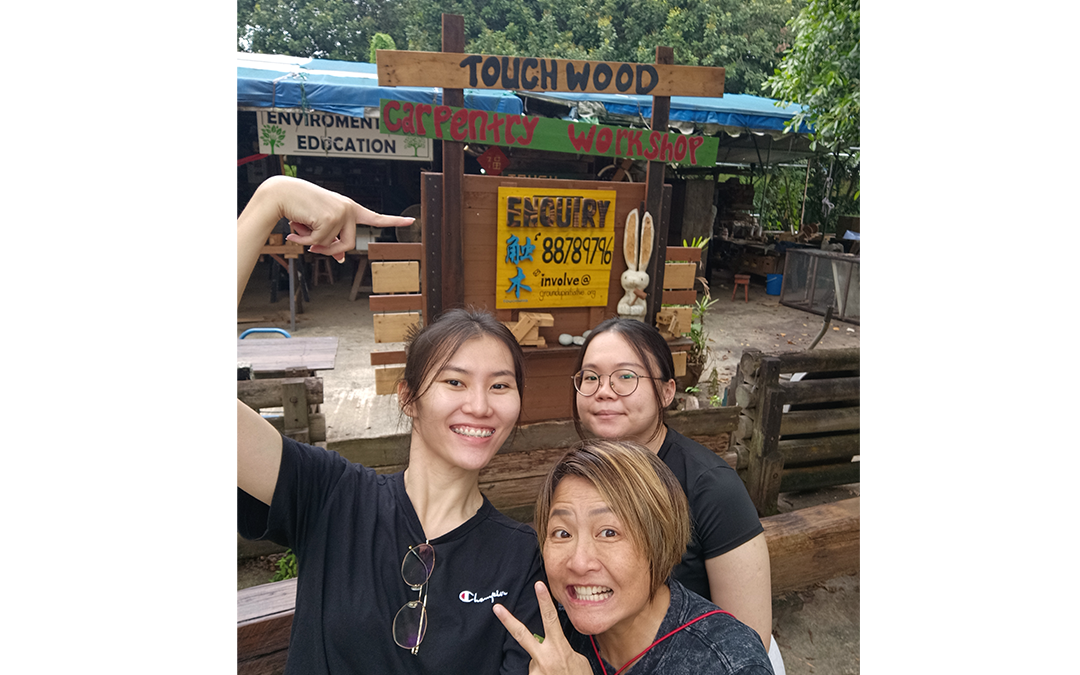Our Farming Experience in Singapore!
Earlier this year, we volunteered at Ground-Up Initiative (GUI) to celebrate Earth Day!
As the creators of Fly-A-Way, wildlife and environmental conservation are very important to us, and we wanted to learn more about sustainable environmental practices in Singapore.
We learned so much from our morning with GUI and wanted to share our experience in greater detail! Our team was split into 3 groups – farming, composting, and woodworking. We’ll have one person from each group share their experiences and takeaways in this blog post!
If you’re interested in farming, sustainability, woodworking or composting, then keep reading! :)
Hazel: Lynette and I were tasked with farming! GUI has a chemical-free farm where they grow lots of beautiful organic produce. This produce is used to cook plant-based lunches for their volunteers and sometimes sold at farmers’ markets.
Each morning on the compound begins with the watering of plants. We started with the large greenhouses, where we used hoses pointed upwards to mimic a gentle rainfall. This helps prevent damage to younger seedlings just beginning to sprout. The hoses were supplied with rainwater that GUI collects for watering plants and washing tools.
After watering all the plants in the greenhouse, we did some soil prep and planting. This entailed layering fresh loam and compost (made on-site at GUI – more details in the composting section below!) to create a fertile base for the seedlings to grow. Then came the back-breaking work of breaking large clumps of soil into smaller pieces using garden hoes. This was laborious but important as large rocks tumbling about could cause damage to young seedlings.
Finally, we got to sink our fingers into the soil! We made holes in the soil and planted the seedlings at regular intervals, ensuring that each seedling would have enough space for its roots to grow.
I was also recruited to saw pipes that could be used to build smaller greenhouse structures. I worked next to the woodworkers, measuring the pipes and cutting them via hand saw to a specific length. I got to try different kinds of hand saws, and learned that the Japanese saw was my favourite for sawing pipes! It was hard work, but gratifying to feel like I was getting better with each pipe!
Rita: To be honest, when Oon Hong, Wan Ni, and I were first assigned to woodworking, we envisioned ourselves creating beautiful wooden furniture such as chairs or tables. However, our task turned out to be extracting nails from wood pallets!
GUI receives pallets from companies that use them to protect their merchandise during shipping. In doing so, they rescue these valuable wooden structures that would otherwise be discarded. While some furniture companies do accept these pallets and repurpose them to craft new furniture, the majority do not due to the additional labour required for extracting the metal nails and sanding down the pallets.
Though extracting metal nails may seem like a mundane task, it is a crucial part of GUI's wood upcycling process and calls for great patience and skill. With our trusty hammers and crowbars, we were on our way to becoming pro nail extractors!
If you ever find yourself with a stack of wood pallets and a desire to upcycle them, fear not! Here's a step-by-step guide on how to remove nails from wood pallets:
step by step - part 1
Lay the pallet on the edge of a flat surface (eg. table) with the nail points facing up.
Hammer the nails through the pallet until they emerge from the other side.
step by step - part 2
Turn the pallet around.
Place the curved claw of the crowbar forward and away from you. (You may want to prop a thin piece of wood below the crowbar for greater ease!)
Position the nail in the crowbar’s nail slot.
Pull the crowbar toward you.
Remove the nail and store it in a container for safety!
After extracting the metal nails, we got to take a look at some of the furniture GUI has crafted. These are benches made out of seats from decommissioned MRT trains and upcycled wood!
The benches were sturdy and looked as good as new. I also saw them placed outside the GUI office for visitors, and I think they brought a touch of personality to the space!
We even sat on one of the benches and posed for pictures with the box full of wood pallets from which we had removed the nails!
Extracting metal nails from wood pallets was a new experience for us all, and learning about the reasons for it made it all the more meaningful. Every upcycled wood pallet is a step toward sustainability and waste reduction! Besides, don’t you think it’d be cool if we had more furniture and art pieces made from repurposed wood?
Russell: In contrast to our colleagues, Key and I were presented with a relatively straightforward job: just move dirt from one bin to another bin.
For the most part, that was exactly what we did. Composting is a multi-stage process, as the combination of dirt, organic material (such as leaves and manure), and moisture gets mixed, then allowed to rest, then mixed again. Each stage in this process was tracked using bins, with a given batch of compost moving from one numbered bin to another as it matured.
Our step in this process was a simple one. Armed with shovels (and at one point a watering can), Key and I moved compost from one such bin to another. Dirt added to the new bin was to be sieved through a wire mesh, such that only sufficiently broken-down particles were introduced; any matter caught by the sieve would be unceremoniously dumped back in an earlier bin. Between each shovel-full of dirt, Key and I were tasked to thoroughly agitate the sieve, filter out the large particles, and occasionally add water to the mixture.
Any trouble we faced lay not in our instructions, but simply in the general laboriousness of it. Each “bin” is better described as a small lot, roughly the volume of a large dumpster. While the shovels were big, Key and my ability to balance the compost on them without spillage wasn’t quite up to match, and each scoop we took was of moderate size only. And of course, simply acclimatising to the smell took some getting used to.
With that said, by the end of it I found myself appreciating a job well done. While – to confess – not exactly an experience we are in a rush to repeat, it was definitely an eye-opening one, both as a reminder to the tiring work that goes into growing our food, and also as to the realities of work on the farm. It’s sometimes easy to romanticise the rural farm, and Key and I – bug-bitten, smelling-of-manure, and covered in a mixture of sweat and dirt – certainly walked away with a more realistic appreciation of it!
Ground-Up Initiative is preparing for a big move! Find out more and support their work here.
















